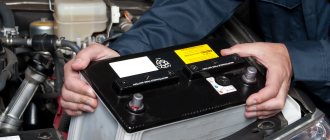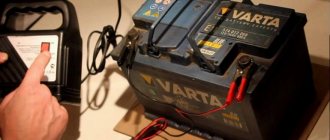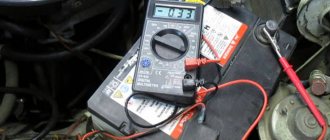How to properly charge a car battery
There are two ways to charge batteries: constant voltage and constant current. We will describe their features in more detail below.
DC charging
This method involves setting a constant current value on the charger. It should be 10% of the battery capacity.
For example, for a battery with a capacity of 70 Ah, the current during charging should be 7 A, for a 60 Ah battery - 6 A.
Unlike current, the voltage supplied to the battery changes during charging.
The inconvenience of this method is that every 1-2 hours you need to adjust the current strength, which requires constant presence next to the device being charged.
The process must take place in a ventilated area, since the electrolyte releases flammable gas when charging.
This primarily applies to serviceable old-type batteries. The more fully charged the battery, the more intense the gas formation.
At the beginning of charging, a low voltage is applied to the battery, and it gradually increases.
When it reaches 14.4 V, you need to reduce the current by 2 times from the original value. For example, if the value was 7 A, you need to set 3.5 A.
After the voltage reaches 15 V, the current is reduced by another half (from 3.5 A to 1.75 A).
Charging continues until the voltage stops changing. If within 1-2 hours the voltage and current parameters stop changing, frozen in one position, then this means that the battery is fully charged and there is no point in doing this longer.
Also, when fully charged, gas begins to flow intensively from the electrolyte (the number of bubbles rising to the surface of the liquid increases sharply).
Constant voltage charging
With this method, a constant voltage value is set on the charger, depending on the type of battery.
At the beginning of charging, the current has the highest value, and the greater the more discharged the battery, the greater the current.
To prevent users from wanting to excessively speed up the charging time, most chargers have limiting circuits that do not allow the current to be set to more than 20-25 A.
This is done so that the charger and the battery itself cannot fail when operating at maximum parameters.
As the battery charges, the voltage gradually decreases, and the current drops to almost 0. The parameter changes exponentially.
The higher the voltage at the beginning of the process, the sooner the battery will charge. If you set the value to 16.3-16.4 V, the battery will be fully charged in about a day, at 16 V during the same time the charge will reach 95-97%, at 15 V - 85-90%, at 14.4 V 0 75-85%.
But too fast a process increases the release of gases, so most modern batteries with a maintenance-free design have a limitation that does not allow them to be charged at a voltage of more than 14.4 V.
How to charge a car battery
A car battery can only be charged from a direct current source that has the ability to adjust the voltage and current supplied to the battery terminals.
Various types of chargers are now offered in stores. There is also a variety of them called charger-starters.
Such devices allow you to start the engine by connecting in parallel to the battery. This can be useful, for example, in winter, in an unheated garage, when the battery’s capacity drops in severe frosts.
The device, designed for charging the battery, converts 220 V alternating current into direct current.
The output voltage must be at least 16-16.5 V. With lower parameters, it will be impossible to fully charge many modern batteries.
The simplest type of battery is called “antimony” due to the fact that the lead from which the plates are made contains the addition of antimony.
The alloy may also contain calcium and sometimes a small amount of silver. The level of constant charging current is set equal to 10% of the battery capacity (for a battery with a capacity of 70 Ah, the current is correspondingly set to 7 A).
The constant voltage for such a battery should be 13.8-14.5 V. As the battery is charged, the current characteristics decrease along an exponential curve.
Battery charging time depends on a number of factors:
- degree of discharge;
- containers;
- battery condition;
- device power for charging.
Charger.
Theoretically, the higher the current value is set when charging, the less time the battery will reach full charge.
But in reality, a high charging current increases the likelihood of discharge. To eliminate the risk of overcharging the battery, which reduces the battery life, many car owners set the charging current to about 2 A.
The battery is left with the charger connected overnight (6-10 hours). With this approach, although the battery is not charged 100%, it retains its charge better in the future.
Please note that before connecting the battery to the charger, it is recommended to clean the contacts from traces of corrosion, plaque, and dirt. After charging, it is advisable to treat the battery terminals with special compounds to protect them from oxides.
5 Best Battery Terminal Lubricants
Important! In order for the battery to last a long time and not fail at the most crucial moment, it must be regularly maintained and monitored the amount of charge, checking it once a month, or better yet, more often. This needs to be done at any time of the year, but in winter it doesn’t hurt to check the battery more often, because in cold weather problems with it occur more often.
If charging is carried out on a serviced battery, then before starting it, you must unscrew the plugs on all banks. You also need to remove the plug.
This is necessary to ensure that the gases formed during the process do not increase the pressure inside the housing above critical and damage the structure.
After removing the plugs, you need to check the level at which the electrolyte is in the jars. It should completely cover the plates.
If the level is less than required, then distilled water should be added to the jars. It is also not worth pouring above the required value.
You should not charge serviced batteries in residential areas. This is due to the fact that when charging, the electrolyte in them intensively releases gas that is harmful to people and flammable.
Therefore, charge in a ventilated garage or other ventilated area where people are not constantly present.
Maintenance-free batteries do not have such restrictions due to the fact that they practically do not emit gas. They can be charged even in an ordinary apartment.
How to do it right
To the question of how long it takes to charge a car battery, you can give a precise answer: on average, this process lasts 10 hours, no less . Experienced motorists recommend increasing the charging time with low currents to 15 hours in order to “pump” the battery properly. Of course, this is quite a long time. But only this charging time ensures full and high-quality battery operation. By the way, to ensure that the time does not drag on for the car owner for too long, you can leave the battery to charge overnight, having previously adjusted all the necessary indicators.
To do everything as correctly as possible, without consequences, it is best to disconnect the wires from the battery and completely remove it from the hood of the car (the battery is allowed inside the car, but only as a last resort). The charging process must not be interrupted : this will negatively affect the battery capacity level. This is how to properly and safely charge a car battery.
When to charge the battery
If the car's generator can handle charging, then there is no need to charge the battery using an additional device.
Therefore, we recommend checking the charge level first.
There are several ways to do this:
1. Voltage check. This method is the easiest and fastest. To carry out measurements, it is enough to have a simple multimeter in your tools.
6 Best Automotive Multimeters
The cost of such a tool starts from 300-500 rubles. Set the tester switch to the position to measure DC voltage up to (or around) 20 V. Then you need to place the red probe on the positive terminal of the battery, and the black one on the negative terminal.
The nominal voltage value for a car battery is 12 V. In reality, it has a greater value.
For a healthy and new battery, when fully charged, it should show about 12.7 V. When half-discharged, this value drops to 12.2 V.
This means that it needs additional recharging. If the screen displays a value of 11.6-11.7 V , then the battery has almost exhausted its capacity, you cannot go on the road with it, the battery must first be charged.
Checking the voltage on a car battery.
2. Check for electrolyte density. The method is only suitable for batteries of the type being serviced, in which the caps can be removed from the cans.
You will need a hydrometer. It is necessary to lower the end of the device into the battery jar, draw liquid into the device so that the float floats up.
By combining the marks on the body with the scale, the density of the electrolyte is judged. For a charged battery it should be at 1.27 g/cubic meter. cm.
If the indicator is lower, this means that the battery is discharged and needs to be recharged. Maintenance-free batteries have a round window on the top cover, the color of which allows you to visually determine the state of charge of the battery.
Battery charge indicator.
3. Difficulty starting the car engine. Most often, problems with starter operation occur due to insufficient battery charge.
If, when the starter is turned on, the lights on the dashboard begin to shine dimmer, then the battery is almost certainly seriously dead.
Attention! It is not recommended to allow a significant discharge of the battery. When in a discharged state, the process of sulfation of the working plates occurs, which leads to a decrease in the battery capacity and a decrease in its service life.
Two types of battery charger
There are two types of chargers:
- Direct current.
- Constant voltage .
Constant voltage memory
The so-called express charging of the battery lasting 5 hours is usually carried out with a popular Chinese charger, which uses the principle of constant voltage (14.4 V). When this device is connected to a battery, it provides more than 10 percent of the current rating: 25-30 A in the first hour of charging. The battery will withstand this current and will charge very quickly, but it will also run out much faster. The current drops in the first 3-4 hours, but the voltage remains constant. In five to six hours the battery will be charged to 90-95 percent.
It is recommended to use such devices only in extreme cases when fast, emergency charging is necessary. However, many car enthusiasts, unfortunately, prefer not to calculate voltage and amperage, but simply buy a Chinese charger that does everything “by itself”. You should not use this method constantly, since in the first hour it gives a very high amperage, which only drops towards the end. If you charge the battery so quickly all the time, it will fail much earlier.
Is it possible to charge the battery in a car?
Novice drivers are usually interested in whether it is necessary to remove it from the car when charging the battery using a charger.
It is not necessary to remove the battery from its seat, but you do need to disconnect the terminals. At a minimum, you need to remove the negative contact, or better yet, both.
The fact is that when charging with the terminals not removed, 2 unfavorable moments arise:
- An electric current with increased parameters circulates in the car’s electrical system, affecting electrical appliances;
- Due to leakage currents, charging time will increase.
In addition, there is the possibility of a power surge that could damage an important electrical appliance.
This is especially dangerous on modern, expensive cars equipped with electronic ignition control systems, computers, and climate control systems. Due to the fact that the terminals were not removed, you can end up with expensive repairs.
How to prepare the battery for charging
Wherever the car battery is charged, the main thing is that the room for this is as safe as possible. When the battery begins to charge, it begins to release toxic chemical fumes. Therefore, the room should be well ventilated and ventilated. Also, you should not charge the battery where there may be problems with electrical wiring in the form of periodic power surges and power outages. Of course, any operation with a battery is carried out where there are no open sources of fire or flammable substances.
It is necessary to charge the car battery by first cleaning it from dirt and dust, and also completely discharging it before charging. Quickly discharging the battery is easily done using a load in the form of light bulbs. One or two are connected to the terminals, and then you have to wait until they go out.
How to charge a calcium battery
7 Best Car Calcium Batteries
Calcium batteries, designated by the letters Ca-Ca, are generally maintenance-free.
They quickly gained popularity due to a number of positive qualities, including:
- high capacity;
- significant starting current;
- almost complete absence of electrolyte evaporation.
However, these batteries also have their disadvantages. Their main unpleasant feature is their sensitivity to discharge.
It is enough to allow a deep discharge 3-4 times for the capacity to decrease several times. Therefore, discharge control and regular charging for this type of battery are critically important.
For calcium batteries, you need to follow the charging technology, which has its own characteristics. It is necessary to purchase a charger that is capable of generating a voltage of 16.1-16.5 V.
If the charger has a lower output voltage, then the battery will be constantly undercharged. So, at a current of 14.8 V, the battery will gain 45-50% of its capacity, at 15.5 V - 70-80%.
At low voltage, a calcium battery can never reach 100% of its capacity. Therefore, you need to buy only modern type chargers.
For example, a suitable model would be the Orion-Vympel-55, equipped with a programmable charging cycle, which allows you to charge the battery with minimal supervision.
The problem is that generators on cars supply a voltage of only 15 V to the network. This means that they cannot fully charge a calcium-type battery.
Because of this feature, this type of battery requires regular periodic recharging once a month. It is especially important to do this in winter, when the battery capacity decreases due to frost.
Calcium battery.
As written above, you need to buy a charger equipped with the ability to program the operating cycle.
The charging process looks like this:
- The voltage on the charger panel is set to 16.1 V. The current indicator should be the standard 10% of the battery capacity, i.e. for a 70 Ah battery, set the current to 7 A).
- The battery is charged with the set parameters until the current drops to 0.5 A. The duration of this period depends on the degree of discharge, capacity and condition of the battery.
- Now there are 2 modes on the instrument panel: upper and lower. Values for the first: 16.1 V and 3 A, for the second - 13.2 V and 0 A.
- The charging device arranges a “swing” that allows you to increase the capacity to 100%. A current of 3 A is supplied to the battery, while the voltage gradually increases to 16.1 V. As soon as it reaches this value, the current becomes 0. The voltage gradually decreases to 13.2 V. Then the cycle is repeated again.
The more the battery is charged, the smaller the “swing” fluctuations in time become; at first it increases for tens of minutes, and decreases quickly.
Gradually, the nature of the work changes to the opposite: a rapid increase in less than 1 minute and a slow decrease over several minutes. This indicates that the battery is fully charged.
Express battery charging using constant voltage method
In order to understand the essence of the matter as best as possible and understand how long it takes to charge a car battery, it would first be a good idea to remember the fastest and most common charging method, which is called universal for modern battery models classified as maintenance-free.
In this case, the charger controls the charging current automatically, and the process itself is safe due to the fact that the formation of gases and the release of harmful chemicals into the atmosphere is minimal.
When using such simple technology, motorists, as a rule, do not “bother” with the question of how long to charge a car battery. It is known that the charging time in this case is no more than five hours, and the battery capacity is replenished by 50% in just an hour. In the next four hours, the battery will be charged more than 90%.
This is how the battery is charged by motorists who do not have the time or desire to take it out of the car. It is, indeed, almost safe, but it is more suitable for extreme cases. In order to “pump” the battery more efficiently and gradually, thereby ensuring the best performance, you need to use a different type of charger.
How to charge a gel battery
5 best gel car and motorcycle batteries
Gel batteries are marked GEL. They have a number of advantages over traditional batteries.
Most often they are used as traction batteries for electric vehicles, for cars with powerful media systems, for SUVs, ATVs, and motorcycles.
They are also widely used to ensure uninterrupted operation of household appliances, computers, volatile gas heating systems, etc.
Gel battery.
Pros of gel batteries:
- They are not afraid of shaking, they can be tilted without the risk of spilling electrolyte.
- The current output remains high even when the charge is only 20-30%.
- They can withstand up to 1 thousand recharge cycles, and often significantly more than this value, depending on the specific model and compliance with operating rules.
- The self-discharge current is very small, thanks to this a charged battery can maintain voltage for a long time. Over the course of a year, the battery loses only 20% of its charge.
- It is possible to store completely discharged for a long time in a room without heating, even in winter.
Disadvantages of gel batteries:
- They are much more expensive compared to traditional type counterparts.
- Overcharging should not be allowed; in this case, the battery capacity and its service life will drop sharply.
The charging algorithm for a gel battery differs slightly compared to a traditional battery:
- An ordinary charger with adjustable output voltage and current is sufficient.
- The current should be the standard 10% of the capacitance rating. It is allowed to increase the charging current to 30% of the capacity (for a battery with 70 Ah this will be 21 A). But this should only be done if the battery needs to be charged urgently. It is not worth doing this all the time because of the reduced service life.
- Due to the fact that gel batteries are sensitive to high voltage, this indicator cannot be set higher than recommended for this model. Usually this is 14.5-15 V. The recommended parameters are always indicated on the markings on the battery case.
- The sticker also indicates the maximum charging current (may also be indicated as max initial current). This value must also not be exceeded.
- The charging period depends on the magnitude of the charging current. It is determined by dividing the capacity by the set charging current. This means that if charging is carried out at 10% of the nominal value, then it will take 10 hours, if 30%, then, accordingly, a little more than 3 hours. For fear of overcharging the battery, it is better not to use old types of chargers, but to use new devices with an electronic unit that automatically monitors the output voltage and current.
Gel battery charging parameters.
Attention! The danger for high-voltage gel batteries comes from the fact that the gel containing the electrolyte begins to deteriorate. Under the influence of current, it begins to melt. The longer the exposure to high voltage, the worse it is for the battery.
When charging a serviceable gel battery, be sure to remove the plugs so that pressure does not build up inside the case.
The charger is connected to the appropriate terminals, then the required voltage and current are set on the device.
During charging, the voltage will increase, so you need to make sure that it does not go beyond the maximum limits (often indicated as cycle use).
If the voltage exceeds it, you need to reduce the charging current in order to also reduce the supplied voltage. Typically, 10-12 hours should be enough to fully charge.
The Standby Use value is also often indicated on the battery, which indicates what voltage should be on the battery in storage mode.
If storage is long, then manufacturers recommend recharging from time to time at a low voltage (usually in the range of 13.5-13.8 V) to maintain performance. This current may be indicated on the label as "buffer" or "buffer mode".
If the voltage indicators are not observed, the battery will quickly fail.
It is best to buy a modern electronic charger for a gel battery with automatic control of voltage and current, which will not allow you to recharge the battery on your own.
Also, such chargers can set the charging mode themselves depending on the degree of rarefaction of the battery and the ambient temperature. There are also charger models specifically designed for gel batteries. It is advisable to purchase just this one.
Attention! If your car has a gel battery model, check from time to time the voltage that the relay regulator on the generator produces. At high voltage current, the battery will become inoperable very quickly, up to several hours. For insurance, you can install battery terminals with a relay-regulator built into them, which will limit the voltage when it exceeds a predetermined one.
What is a car battery?
Car batteries are types of electric batteries. They are used on cars and motorcycles. Its purpose is as follows: starting the engine, serving as a power source in the vehicle’s on-board system when the engine is turned off. It also plays the role of a voltage stabilizer for the vehicle. The most common are 12 volt batteries. They are found on cars, mini buses, and also on lightweight trucks. Batteries with a voltage of 6 volts are built into motorcycles. And the 24 volt battery is installed in heavy trucks and military equipment.
car battery
To start the engine, the battery must crank, which is provided by the starter. It receives power from the battery. At such a moment, it uses a lot of energy, thereby discharging the battery itself. Once the car starts, the power supply goes to the generator. The scheme is this: driving a car recharges the battery.
How to charge a hybrid battery
4 best hybrid batteries
The peculiarity of hybrid batteries is that they use plates with different additions of alloying elements.
Some of the plates are antimony, others are calcium. Such batteries are low-maintenance, but the banks are equipped with plugs.
Therefore, it is necessary to check the electrolyte level in them. They do this every 2-3 months. If the level drops below the required level, distilled water is added.
The main advantages of hybrid batteries are that they tolerate deep discharge well, delivering significant starting current.
They also stand out for their low cost, which is approximately 2 times lower compared to calcium batteries.
Hybrid battery for car.
Charging a standard type battery is no different from working with traditional batteries. The current indicator is set at 10% of the battery capacity.
But it can be increased to 30% if you need to complete the cycle in a short time. The best performance is achieved with a current of 3% of the capacity.
For a capacity of 60 Ah, this is 2 A. The voltage should be 13.8-14.2 V. Charging is stopped when the voltage rises to 14.2 V and the current decreases to 0.3-0.5 A.
Attention! It is better not to set high current levels, as this leads to boiling of the electrolyte. The danger of this process is not only the release of harmful gases, but also that the plates are heated, from which the active mass begins to crumble.
For hybrid batteries, it is necessary to regularly monitor the level of the electrolyte in the summer.
The fact is that the battery produces a higher voltage than traditional batteries. This feature improves engine starting, but in summer it leads to heating of the battery, which is why when the engine is turned on, the electrolyte heats up and boils.
As water evaporates, the electrolyte concentration increases, its level drops, and the plates are exposed to air, beginning to collapse.
Charging time depending on battery differences
There are two types of batteries: maintenance-free and maintenance-free (or low-maintenance).
Such batteries contain acid and it is not recommended for the average user to work with such a device. Chemical liquid dripping onto clothing can burn it. If acid drips onto the skin, immediately wash the affected area with cold running water. Experts do not recommend using or charging a faulty battery unless the user has specific knowledge and extensive experience. It’s better to help and tell you how to charge the battery at home yourself and in what situations you shouldn’t do this. All batteries can be divided into serviceable and maintenance-free .
- The design of serviceable units implies the possibility of replacing components - most often the electrolyte. Due to poor sealing, the electrolyte periodically evaporates, which leads to a decrease in the performance properties of the car battery. Also, when working with such devices, there is an additional risk of injury due to the possibility of contact with an acidic environment and lead. But 100% charging, accompanied by boiling water, will be visually visible to the naked eye.
- The design of the serviced types excludes the possibility of working with the insides of batteries. The process of boiling and evaporation of water is completely eliminated due to the tightness of the housing. But with a large number of recharges and discharges, the lead plates are destroyed and the electrolyte solution becomes purple. This entails a reduction in amperage, so such unsuitable devices must be disposed of.
How to charge an AGM battery
AGM technology is often confused with gel technology. In fact, these types of batteries differ significantly.
AGM batteries are capable of delivering a high starting current, reaching values of 500-900 A. This allows you to start any car, even with a diesel engine, in almost any frost.
Also, such batteries charge much faster (almost 3 times). An important advantage of AGM batteries is their extended service life (3-5 years longer than a traditional lead battery).
AGM battery for car.
There are 3 options for charging AGM batteries:
1. Charging, accumulation and storage. Charging the charger can be done from the battery in the car or using the charger. The voltage is in the range of 14.2-14.8 V, but should not exceed 15.2 V (you need to clarify this point in the instructions for the battery).
The charging current is within 10-30% of the capacity. The energy storage process is carried out after a deep discharge. In this case, the voltage should be as described above, and the current should be 10% of the capacity. In case of storage, the voltage does not change, and the current strength is 5-10%.
2. Charging and storage. This option is most often indicated by manufacturers. For charging, parameters of 14.2-14.8 V are used at a current strength of 10-30% of the battery capacity. In case of storage, the voltage is 13.2-13.8 V at the above current strength.
3. Charging. Some manufacturers do not report the storage conditions at all, but only indicate the parameters for charging. They are the same as in the paragraph above - 14.2-14.8 V at a current strength of 10-30% of the battery capacity.
For AGM batteries, it is also important to maintain the recommended voltage and charging current.
It is best to use a charger with an electronic unit that has 2 modes. The presence of such a charger allows you to charge the battery without constant monitoring and guarantees that the current parameters will be within the specified range.
If you use an old charger, you will need to constantly monitor all parameters manually.
The basic principle of charging current control
There are two main principles:
- Do not exceed the maximum current equal to 1/10.
- Do not set the initial value below 1/20 of the battery capacity.
Applying electric current to the terminals causes a complex chemical reaction in the electrolyte and on the surface of the lead plates. When the process proceeds moderately, they gain a full charge without being exposed to danger.
Exceeding the required level causes too violent a reaction. Several such charges can simply destroy the plates.
Low current is also harmful. In this case, only the outer layer of the plates will be charged. After which the charging current will drop to zero, and the voltage will increase to the specified value. It would seem that the battery is charged. But that's not true! The plates become sulfonated, do not take on a charge and become passive.
In both cases, the battery will have to be thrown away.
How to charge a maintenance free battery
Many models of modern batteries are maintenance-free. They do not have access to the banks, so they will not be able to check the electrolyte level and add distillate to them.
Such batteries are charged in the same way as conventional ones, in 2 ways: with constant voltage or constant current. It is best not to take risks, but to buy a modern charger with an electronic unit and a charging end indicator. Typically, upon completion of the cycle, a color indicator on such a device lights up.
The old, mechanical type charger will have to be controlled by yourself. You will need to determine the degree of battery discharge.
It can be determined by the voltage at the battery terminals. 12.7 V means it is fully charged. 11.7 V – complete discharge, 12.2 V – 50% discharge.
The charging current should be 10% of the battery capacity. For example, with a half discharge and a battery capacity of 60 Ah, 30 Ah will be required to restore capacity. 10% of 60 Ah is 6 A. 30 Ah divided by 6 A equals 5 hours. Therefore, the charging time will be 5 hours.
The charging current threshold of 10% cannot be exceeded. Such an experiment is guaranteed to lead to failure of the battery or at least a reduction in its capacity and service life.
Overcharging has a fatal effect on any type of battery. If the charging cycle takes 5 hours, then keeping the battery with the charger connected for 8 or 10 hours is not only pointless, but also harmful.
In this case, the amount of charge will not increase, but the electrolyte will boil, which will lead to the evaporation of water from it and heating of the plates.
This process is especially dangerous for a maintenance-free structure. If in a battery equipped with plugs it is possible to add distilled water, then in a maintenance-free battery this possibility is completely absent.
The battery is equipped with a special valve that relieves pressure when the pressure inside the housing exceeds a critical value.
This protects the battery from destruction, but the loss of fluid is irreversibly compensated. Lowering its level below the required level will damage the plates and reduce the service life of the device.
Therefore, you should not allow a maintenance-free battery to be recharged for more than 15-30 minutes.
Charging time
Charger
Another very pressing question is how long to charge a 60 amp battery? The charging speed directly depends on the set current and voltage and the degree of battery discharge. Accordingly, the greater the supplied current and voltage, the faster the battery will be fully charged. If you follow all the above recommendations, a single charge cycle will last about 10 hours.
Some car enthusiasts, wanting to save their precious time and being in an eternal rush, use another unsafe method of charging the battery. They set a current strength exceeding 20 amperes, and the charging itself lasts no more than 5 hours. Of course, you cannot constantly charge in this way - the battery will quickly become unusable. However, in emergency cases this technique can be useful.











